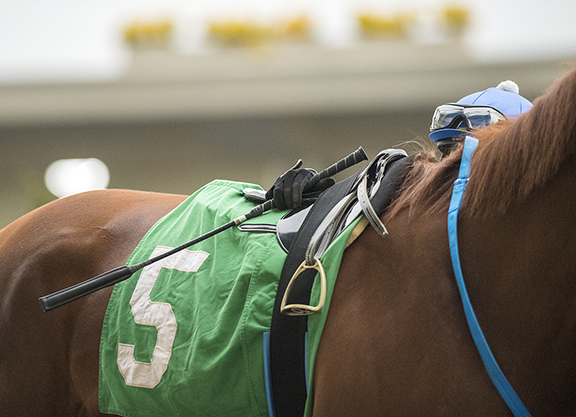By T. D. Thornton
The Kentucky Horse Racing Commission (KHRC) is on its way to a long-planned rewrite of the state's whipping rules, and the chief change would set a limit of six overhand hits per race with no more than two strikes in succession to give the horse a chance to respond.
In addition, the penalty structure will be tweaked. As explained by Jennifer Wolsing, the general counsel for the KHRC, “The stewards would be able to impose a $500 minimum fine or a three-day minimum suspension. Or, if the stewards believe that the violation is egregious or intentional, then the stewards could impose both.”
Last June, the KHRC voted to advance extensive whip-rule changes based on a limit of six underhanded strikes per race. But that proposal ended up getting paused when it became evident to the commission that the legislature was unlikely to approve it into law.
The KHRC's Rules Committee voted in the new round of proposed changes on Monday. The full KHRC board still has to vote on the measure June 15, but there doesn't appear to be any impediment to passage, KHRC executive director Marc Guilfoil told TDN in a follow-up phone call.
The measure then would have to be approved by the state legislature, whose leaders have indicated support for this latest version. Guilfoil estimated that legislative process could take seven or eight months.
“So it should be in effect–if everything goes good, and I don't see why it wouldn't–by February of next year,” Guilfoil said.
Stakeholders who contributed to the May 3 compromise, which got hammered out over the last few weeks after being extensively debated for the past year and a half, voiced agreement that this latest version still isn't going to be ideal for everybody, but that it could end up being a good enough fit to provide a workable model for a uniform rule across all jurisdictions.
“You strive to get the perfect rule. You don't always get there,” said Guilfoil during the tele-meeting, noting that the KHRC has been working with everyone from jockeys to legislators to try and get its rule right. “I think this is something that everybody can live with…We're going to start talking to some other states, and see if we can get uniformity.”
Terence Meyocks, the president and chief executive officer of the Jockeys' Guild, told the Rules Committee his members are willing to go along with this proposal in the interest of trying to get a continent-wide rule on the books.
“Hopefully, we adopt a rule in Kentucky that could be an important first step to the adoption of a uniform riding crop rule in North America,” Meyocks said. “It's important that we remember that there was indeed compromise on behalf of both parties, the riders in the Guild and the KHRC. Having different rules in so many different various states is no good for anybody.”
The KHRC's chief state steward, Barbara Borden, said the revised penalty structure would be particularly useful moving forward.
“There are many times we struggle with the mandatory penalties that are scattered throughout our regulations and don't always give us discretion when we feel like we need it,” Borden said. “So in this instance, we're pleased with the way this is written, that we have a baseline to start with. And should a person violate a regulation over and over again, we like the penalties to escalate, particularly if it's an egregious offense or if we feel like somebody is just ignoring the regulation.”
Currently, most first-time whip-rule violations are penalized with a $250 fine, Guilfoil told TDN.
Wolsing said jockeys will be limited to “six instances of overhand use of the crop at any time. The overhand use of the crop cannot go above the rider's helmet. And the rider would not be able to use the crop in the overhand fashion more than two successive instances without giving the horse a chance to respond.”
Wolsing continued: “Backhanded or underhanded-fashion use of the crop is going to be okay from the three-eighths pole to the finish line. It will always be okay to tap the horse on the shoulder in the down position as long as both hands are on the reins and on the shoulders of the horse. And certainly showing and waving the crop in front of the horse is also okay.”
There was brief debate over why six strikes has evolved as the standard. Wolsing explained that it's important to note that in Kentucky, the state constitution bans “arbitrary and capricious actions by state governments,” so the number of hits has to be codified and can't be left up to a judgment call by the stewards.
“At some point you have to have a certain number of strikes,” Wolsing said. “This is a number that has been adopted by other jurisdictions as well. It's a very reasonable number [and a number that stakeholders arrived at by] taking into consideration what would be appropriate for the jockeys as well as the horses.”
Wolsing said she foresees no problem with the commission being able to defend that six-strike number if it ever got challenged in court.
Mike Ziegler, the senior vice president and general manager of Churchill Downs Racetrack, said during the meeting that the change represented “a good balance,” adding that, “We're not going to let 'perfect' get in the way with 'really good.'
“Let's get this thing going, turn the page, and get on to other things,” Ziegler said.
Not a subscriber? Click here to sign up for the daily PDF or alerts.






